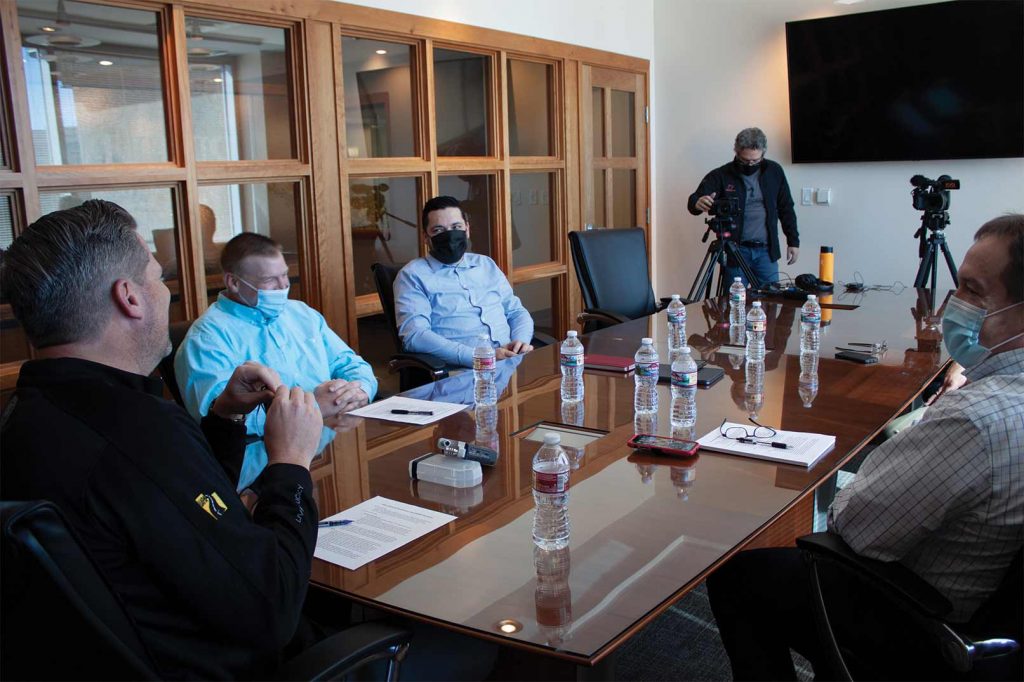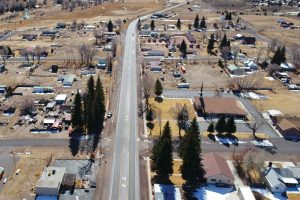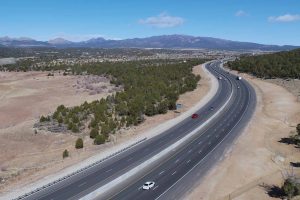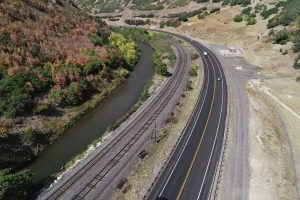By The Utah Asphalt Pavement Association
I am the executive director of the Utah Asphalt Pavement Association. Here in 2021, we have a wonderful opportunity to celebrate 10 years since the inception of UAPA back in March 2011. UAPA is, of course, near and dear to my heart not only because I am currently the executive director of the association, but because I was granted the opportunity to become the very first, and so far only, executive director of the association, it’s been a special privilege of mine to watch as we have brought together companies, agencies, owners, consultants, contractors, and anyone else that touches asphalt from design to its construction and even on to its maintenance and preservation. This team approach is the part of the association that helps make us who we are. As I look back on these 10 years, I can’t help but think how grateful I am for the people that have really made UAPA what it is and hopefully grow into what it can be. There are opportunities and chances that I think still await each and every one of us as we contemplate what the association has been, where it is now, and where we might be able to go.
As I think about UAPA, I think about Alexis de Tocqueville, a famous French diplomat that came to the United States in the 1830s and 1840s. One of the very first talks that I gave to UAPA members at our annual meeting was about what Alexis de Tocqueville observed in America. He observed the incredible ability of Americans to come together, and that has always stuck with me, whether it’s through associations or through shared interests: the ability for us to come together and to unite as one. I recently read an article that shed a little more light on what he observed and what he coined thereafter. In fact, he was the one that coined the term individualism.
The thing that was interesting for him was the balance that we draw together as individuals, of those individuals that come together, and really, the way to frame that is self-interest rightly understood. All of those individuals, taking themselves as an individual organization, are self-interested, as they should be, but when we come together with UAPA, we understand that self-interest has a greater purpose, and it’s rightly understood that we’re stronger together, and when we’re together, we can unify. When we’re unified, we can take that voice, and we can make a difference. You may think, well, it’s just roads and that’s true. It’s just roads. But those are roads that take us to our families; those are roads that take us to our loved ones; those are the roads that connect our community; those are the roads that the trucks drive on that bring us our supplies; and those are the roads on which we enjoy the beauty and the nature that is incredible and second-to-none in this state.
I’m proud to be a part of the association that just makes roads, with all of the beautiful things that those roads do as a result. That’s what I think about when I think about UAPA. It’s all of the great people that make that happen each and every day, and they are people that largely go unknown, but they do a wonderful job, and I’m just proud to be a part of it.
Thanks to all our wonderful members, thanks to all our potential members who are yet out there, and I know who you are. I want you to be a part of this because we’re building something great, and we still have a long way to go, and we need you to be a part of it.
Happy 10-year anniversary to the association. I’m excited for the next 10 years, and the 10 years beyond that, and the 10 years beyond that. I know that we will all continue to be a part of it and to do our part to do the very best. Thank you, UAPA, and thank you to our wonderful members.

Reed Ryan
This spring, in recognition of the Utah Asphalt Pavement Association’s 10th anniversary, a group of leaders within our organization met and discussed the past, present and future of UAPA.
With ten years of history, lessons learned, and industry best practices, our group of leaders reflected on and shared their thoughts on these topics:
Q: As an association, UAPA is still largely feeling the effects of COVID-19 (no in person asphalt conference, virtual committee meetings and interactions with partners in agencies, cities, counties, etc.) — as a result of this past year, give me a personal takeaway and an organizational takeaway that has helped you and your organization grow or become better as a result of the pandemic.
“I think that we will all continue to feel the effects of this past year. I think we learned different ways to accomplish what we needed to.”
“I’m really proud of our industry. I think we adapted. I think we learned some ways of doing business that we will keep. I think people are more versed with “Zoom” meetings and some of that will stay.”
Q: In March of 2011, UAPA came into existence when 10 charter members signed on to a three-year commitment to get the association up and off the ground. Now, close to 10 years later, we have 126 members, nine functioning and active committees and councils, one of the largest asphalt-related conferences in the country, and relationships with agencies, owners, and partners across the state. This includes work on multiple specification revisions, a robust lunch and learn program, and the recent launch of a certification program. Giving credit where credit is due, many of you have helped to make all of what I just listed a reality. What would you like to see the association do next?
“What we have accomplished far exceeded our original goals. You know, five years ago there was some thought given to the notion that we had plateaued. We’re far from that. I think the sky is the limit.”
“We literally house the majority of the technical expertise in the state when it comes to the asphalt paving industry. We’re on the cusp of putting together a world class certification program. We’re a technical body that supports our industry.”
“The educational opportunities are exceptional. The industry isn’t slowing down.”
Q: What is your outlook for the 2021 construction season?
“Our industry is bright. I’m not sure I would have said that a year ago, but the industry did well in 2020, and I think it will do even better in 2021.”
“Another year of growth. Funding is good. The outlook has been good. Overall in the construction industry, it’s good. For Utah, we’re in a pretty good place. Our legislature sees the value of building and maintaining roads.”
Q: From the new Biden Administration on down, we are hearing terms such as resiliency and sustainability used more and more — what do you think this means for your organization and in our industry?
“We’re in an industry that is recyclable. We need to tout that, and we need to educate the public and our legislature more. We need to shine a bigger light on the fact that we’re being good stewards.”
“Recycling. We can recycle everything in our industry.”
Q: Any developments in industry happening now or on the near horizon that you feel will offer significant advancements to any aspect of the pavement industry?
“Improving quality of products — like balanced mix. Great technological advancements are coming. Balanced mix design will be instrumental.”
Q: When thinking about our shared industry what keeps you up at night?
“We have some huge hurdles. We need to use crude produced products for our asphalt. Permitting issues. Making sure that our supply chain is stable and that we use those supplies wisely.”
Q: Five or 10 years from now, what is your hope for the asphalt pavement industry generally and in Utah?
“The 10-year goal is transcending the borders of Utah. We’re a reliable source for building better roads. I would like to see us share our resources with others.”
“I hope that in 10 years’ time we have made progress on bringing up the next generation in this industry. We need to make asphalt sexy.”
“I’d like to see us be that whole state resource, where our presence is equally strong in the northern and southern regions. We’re making good strides.”
Q: Some of you have grown up in and around this industry; others of you have come from a variety of life experiences and choices that led you to this point. Tell me, what initially drew you to this industry — specifically for those of you who came from another path and, if you grew up in the industry, what keeps you here?
“We’ve all had various paths to this industry. I came from building houses. That was incredibly rewarding to see something where there was nothing. I transitioned into this industry because I like to see what I do impact people for the better. And that’s what keeps me around.”
“I love what I do; there’s tremendous job satisfaction in this industry and the opportunities are so broad.”
“There’s a lot of job satisfaction. Driving on a road that I had a hand in building is a good feeling.”
Q: If a high school student came home today and told their parents, “I want to build roads and work in asphalt,” what do you think the initial reaction of their parents would be? How might we work to change that perception?
“There’s a lot of young folk with steep student debt. This field provides many opportunities for good, solid careers. There’s a lot of good people building our roads, we need to do a better job of connecting the dots. We need to get the word out.”
Q: Over the last couple of years, I have participated in a lot of national and regional discussions and meetings regarding the workforce related challenges our industry is and will be facing — during that time, a lot of ideas tend to focus on what I would call the “meta” which does great in identifying our needs, but not so great in achieving actual results. In your opinion, what are some more measurable and achievable results that we could be taking to address the workforce development issue?
“Unify our voice and have that voice heard. Think holistically about what’s right for our industry and our organization. Get buy-in. This makes me excited.
“You may think, well, it’s just roads and that’s true. It’s just roads. But those are the roads that take us to our families; those are the roads that take us to our loved ones; those are the roads that connect our community; those are the roads that trucks drive on that bring us our supplies; and those are the roads on which we enjoy the beauty and the nature that is incredible and second-to-none in this state.”
Thank you to our participants:
Brian Burr, Staker Parson Materials & Construction
Doug Watson, CMT Engineering Laboratories
Jeff Collard, Hales Sand & Gravel
Victor Johnson, Geneva Rock Products
Craig Fabrizio, Staker Parson Materials & Construction
Jeremy Thomas, Suncor Energy
James Clark, Crafco, Inc.
Jeremy Leonard, Western Rock.
To view Reed Ryan’s Intro video, please visit the UAPA website at: https://utahasphalt.org/about-us/
The full version of the roundtable discussion is below. Enjoy!






